 Facebook
Facebook
 X
X
 Instagram
Instagram
 TikTok
TikTok
 Youtube
Youtube
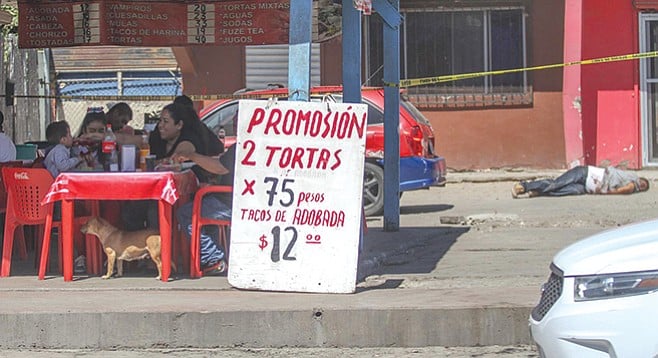
Those words of the late Rafa Saavedra (2013), one of Tijuana’s favorite writers, struck a chord in me. I am a Tijuana outsider who has been trying and failing to decipher la city since I moved here in 2012. Nothing has been the same since Rafa’s passing. Nothing is ever the same here.
I read that quote on the second floor of the new taproom and art gallery in downtown Tijuana on the famed (infamous?) “Revu” near Calle Segunda. Border Psycho, one of the top breweries in the city, opened their second bar in a spacious building that used to be La Ballena, the longest bar in the world when it was opened (circa 1945). The new brewery joins a plethora of new businesses that are refurbishing abandoned buildings and forming the New Tijuana.
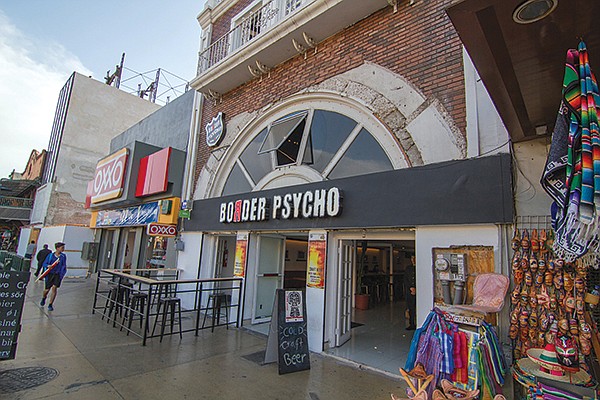
“What happened with our neighbors [Bar El Torito], happened at four or five in the morning. We are closed by then,” says Bruno Arena, one of the three partners of Border Psycho.
“Free tequila shot, my friend. Come in, no cover!” Just a few steps away from the new taproom, jaladores in El Torito Bar try to lure anyone that walks by. A place that refuses to change along with its surroundings, the bar applies old tactics that gringos up through 1990s would fall for. Nowadays, few lost tourists will step inside during the day, but late on the weekends it’s packed with cholos.
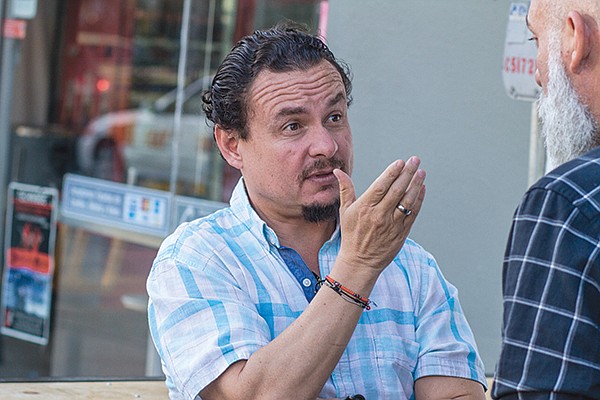
On October 22, 2017, a month before Border Psycho opened, an armed man, supposedly tied to the cartels, entered El Torito and opened fire. The man injured four women employees of the bar and five men. One of the men died from his injuries later that day. The assailant tried to escape but was detained a mile south in Cañon Johnson. Less than a week after the incident, El Torito opened as if nothing had happened.
“It’s a strong sense of insecurity, a concern not only in Tijuana but felt all over Mexico,” continues Bruno. “It’s people that are involved with something illicit, thus the result. But security esta muy bien here in Avenida Revolución. The tourist police do their rounds, cops on motorcycles constantly patrol the area.”
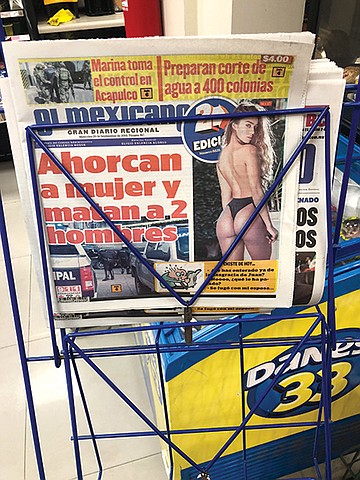
Tijuana gained a reputation as one of the deadliest cities in the world in 2008 with 844 murders. The year 2017 doubled that number with over 1600 murders; 2018 is on the way to break last year’s record, with an average of half a dozen murders daily.
The people that walk Avenida Revolución continue to be the same eclectic disaster, with hordes of locales, Gringos perdidos, beggars, jaladores, junkies, street performers, junk salesmen, punketos, policletos, cholos, lowriders, and me.
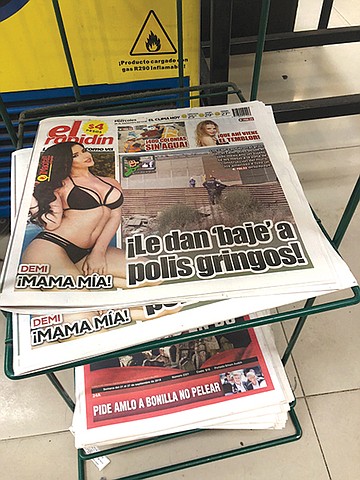
SITT, the rapid bus system that supposedly came this year to fix the horrible public transportation and reduce traffic, instead has made it worse. The $60 million investment that was meant to serve over 100,000 users a month is barely used. Some stations were abandoned before completion and many were vandalized.
Tijuana is libertarian hedonism stuck in fake progress.
Sandwiched in between El Torito and Border Psycho, another new business opened in 2017: Gorditas Doña Tota, a gordita chain from Tamaulipas with over 200 stores in Mexico and the US. They opened a handful locations in Tijuana during that summer. Next to the new brewery is one of the thousands of Oxxos, immediately followed by the old Aloha Club that burnt down in February of 2011. The legend tells that the devil danced with a woman and then set the place ablaze.
Many businesses come and go in a blink of an eye. Less than a year after opening, the downtown location of Gorditas Doña Tota closed its doors in August. At the same time, demolition started on the legendary Aloha Club that had been abandoned for years.
North on Revu (from Segunda) and under the Arch (also known as El Reloj - the Clock) lie the wonders of Zona Norte. The timeless anarchy zone that smells like fried chicken, and is littered with prostitutes, alcohol, and drugs. La Zonaja is the most visited part of Tijuana.
Hong Kong, the most famous of the area’s brothels, built a 12-story building this year in less than five months. A palace of orgies and intense depravity where they sweep the floor with thousands of dollars, it’s one of the tallest building in downtown Tijuana. In its proximity are similar clubs, many sad looking prostitutes, a church, alleys, and eerie bars with people injecting all sorts of drugs, street tacos, seafood stands, Kentucky Fried Buches — which sells fried chicken necks — and plenty of policía enjoying their abuse of power. One street vendor cooks giant pancakes (even at 5 a.m.).
Dead bodies are found daily in the alleys of Zona Norte. Thousands of tourists stumble out of the clubs and back across the border with wild stories to tell. Rinse. Repeat. Extreme sin has its consequences.
“Hey! Ey! Güey...! Vato! Where are you?” bartender at Nelson (and friend) Selene Ramirez texted me impatiently early on a Tuesday afternoon. Bar Nelson sits at the entrance of Zona Norte right under the arch. As usual, I was working at home. “Get down here! Bring your camera! There is a dead body over at Mutualismo y Tercera. There are journalists here already and they are closing down the street.”
The cross streets mentioned are two blocks away from my apartment. “Oh well, I don’t care, I’m going to take pictures,” Selene replied after I told her that photography around police is a bad idea. Homicides in the city occur way too often and the cops aren’t friendly with journalists. “You were right, ya me cagaron el palo por grabar.” (They already bugged me to stop recording).
Not even an hour went by before Frontera had an article about the shooting Selene described. A summary of the article, translated, reads:
“A young man of approximately 21 years old was executed this afternoon at plain daylight. At 13:25 hours, people walking in the vicinity reported the incident near a rehab center. When police arrived, they found the victim on the ground with multiple bullet wounds. He was pronounced dead at the scene by paramedics. Anonymous witnesses gave details that the assailants fled in a brown Toyota Highlander. With this Tijuana reaches 1588 homicides, 141 in August.”
I walked by the street a couple of hours after the incident. There was no indication that anything occurred except broken police yellow tape left hanging from a post.
By September 19, that number had reached 1781 total homicides in 2018.
Every morning, Zona Norte wakes up and goes on as if nothing had happened.
La city sprawls ceaselessly. Growth continues rapidly in all directions, west, south, east, and more recently, upwards at a dizzying pace. Dead bodies are found everywhere. From the sepia-looking Otay, home to its maquiladoras and hidden foodie treasures, to the relatively calm and Americanized neighborhood of Playami (Playas de Tijuana). From shanty favela-like hillside settlements where the houses are made of garbage to the high-end Beverly Hills-esque houses of Chapultepec and Hipodromo. From its drug dens and alleys to its BajaMed fine dining.
The front page of Tijuana’s newspapers are stuck in Groundhog Day. The headlines usually read: ‘Number of people murdered in this and that part of town.’ A half-naked woman decorates the side of the paper with a featured double-spread picture on the middle page. Gulp down the sad news and cleanse your eyes with a plastic-looking beauty printed on recycled paper before you move into the sports section.
“Güey!! There’s a shooting in Santa Fe going on right now!” Selene texted me two weeks later at around 8 pm. “They closed all the streets, you can hear gunshots everywhere, police rushing by in all directions… this is crazy!”
Santa Fe is a dense low-mid-class residential area located 11 miles south of the border.
“My dad went out looking for my mom and sis like an hour ago and he hasn’t come back. I’ll give you more info soon, all entrances are still closed. It is never like this, esto si se puso bien culero! (This got really nasty)”
A few minutes later, Selene informed me that her family was okay and proceeded to send me blurry video, taken from her window, of the shootout happening a few blocks away. The news spread quickly online as other videos closer to the shootout were posted by reporters and shared to several Facebook pages.
“The most bizarre thing about this whole ordeal is that the panadero is still yelling ‘PAN VENGA POR SU PAN’ valiendolé madre la balacera.” (‘Bread, come get your bread,’ not giving a f about the shootout).
What happened in Santa Fe is unclear. The official report is that the police were able to eliminate four kidnappers and rescue the victim. The images of what occurred are gruesome. The rescued victim remains unidentified and it is unknown how long he was held kidnapped.
Yet, Tijuana carries on.
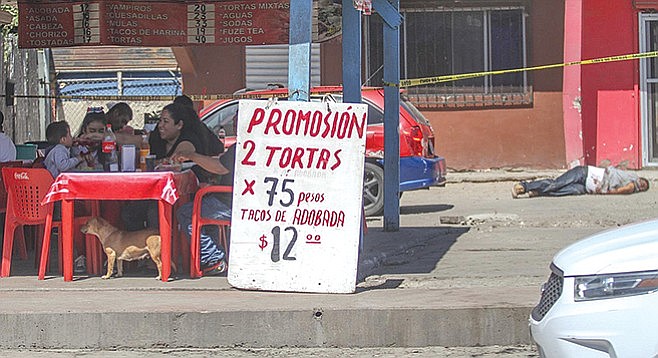
A picture posted by Frontera News by photographer Gustavo Suárez went viral. It depicts a family eating happily at a dusty street taco stand, a bloodied corpse of a man lies only a few feet away.
Tijuana. The name has such a nice, resonating shocking ring to it. Mention Tijuana. Get attention. The band Tijuana Panthers gladly took the city’s name without ever stepping foot in la city.
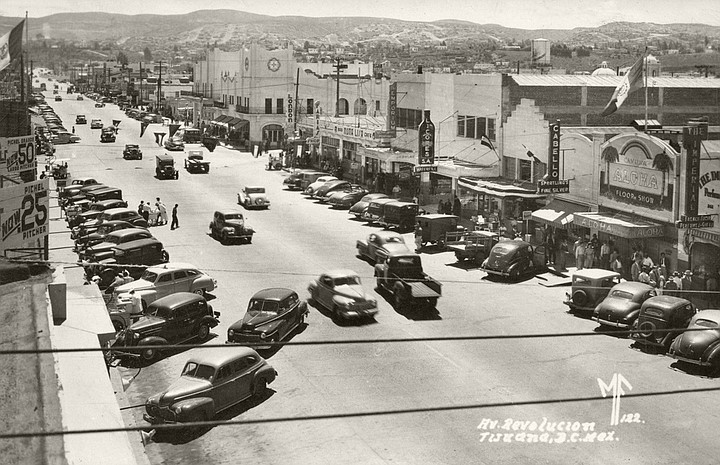
Tijuana, the city where the brightest lights are provided by US taxpayers and the dollar does as it pleases.
The undecipherable Tijuana lures people in. Come visit and discover the “new and improved Tijuana.” It is not what you think it is and each time you come it will be different. Tourism of all kinds is on the rise and so is violence and crime. Bars, cantinas, tap rooms, strip clubs, restaurants, art galleries, and other inventions continue with a steady influx of customers and their dollars.
The city morgue received hundreds of bodies a month this year, surpassing its capacity to handle corpses, both from the lack of staff and freezers. The stench of death mixes with the smell of untreated sewer waste in la city.
And thus Tijuana continues Tijuana-ing. Changing everything. Not changing at all. Welcoming travelers and deportees. Growing carelessly like weeds. A clumpy messy urban spirit with the attitude of a dusty forgotten village constantly reinventing itself.
“Es tan lindo estar de regreso che!” (it’s so nice to be back che!) said a stranger with a broad excited smile as he ordered an especial near me at Nelson Bar. His accent and use of “che” betrayed him as an Argentinean as he told everyone and no one in the bar how great it was to be back after so long. Since he sat one stool next to me, I indulged him.
“I just came back from Europe,” continued the stranger. “I started in Brussels, went to Amsterdam, and then France. There, I stayed with a friend from Tijuana and a Frenchwoman who used to live in Tijuana. I have traveled all over Latin America de mochilazo, similar to what Che Guevara did, but in my own way. I have a certain affection for Tijuana, so that when I leave, I miss it.”

The stranger turned out to be 32 years old, Bruno Lazcano, the main chef of Riochia 7, a cozy restaurant hidden in Colonia Alemán.
“Tijuana is filled with opportunities. When I got here in 2010, I didn’t know anyone and downtown was empty, and it was considered a dangerous city. The restaurants or breweries you see now weren’t here. I started selling empanadas here in downtown and by word of mouth, I would sell ten dozen a day. One of my customers turned out to be Hugo, an Argentinean that ran La Fonda Argentina. His chef just quit and asked me if I could fill in. I wasn’t really a chef, I only knew how to make empanadas because my mom taught me, but when you are looking for work, you say yes to everything. That’s how my love for the kitchen started.”
“Everyone told me that Tijuana wasn’t Mexico, so I saved money and started to travel the rest of the country. I worked in restaurants in Playa del Carmen, Mexico City, and more, then with the money I earned I would travel for months. But somehow I always end up back in Tijuana.”
Bruno continued telling me stories about his travels around Mexico and the world.
“I don’t miss Jujuy (Bruno’s home province), I don’t miss many things from Argentina, but there is something that bonds me to Tijuana. Of course, I miss my friends and family and the convivencia del asado (Argentine meat grilling). But Tijuana is the place where I feel I fit in the most. It’s where I’m the most comfortable and fluid compared to other places. Sure, Europe is nice, but it doesn’t complete me, not sure what it is, me entendes? (you understand me?) Here, the people complete me, and you can do whatever you want at whatever time you want. If you want jazz, you can listen to jazz, if you want theater, there it is! Salsa dancing? No problem. Theater, events, music, it provides whatever you want.
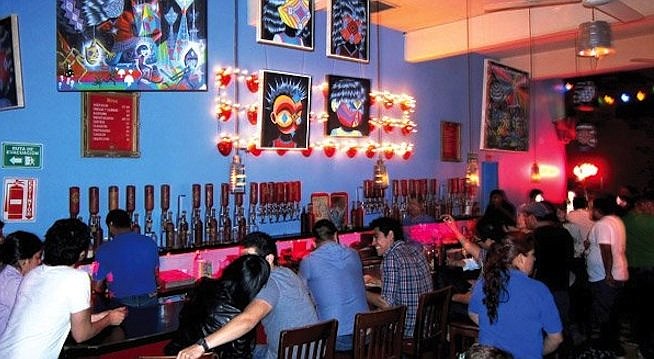
“There are people from all over, you can live the culture of all of Mexico and from other countries. Change is there, but not fully structured to what the Tijuanense culture can be. Tijuana gets up on its own, I like the city’s impulse, it is filled with creativity. Perhaps it’s me, and the way I fit in here. I have to fit in various social contexts, but in Tijuana is where I fit in the most comfortably.”
Bruno’s friend arrived at Nelson Bar and I was introduced briefly. Before I left, I welcomed Bruno back to Tijuana. “I got this when I first got here,” Bruno lifted up his shirt to reveal a big ‘I <3 TJ’ tattooed on his chest where the heart is. “I was young and reckless and this was Disneyland to me.”
Just like Bruno, and many others, I feel the most comfortable in this city. I exist in my very own Tijuana. And yes. My Tijuana makes me happy.


Those words of the late Rafa Saavedra (2013), one of Tijuana’s favorite writers, struck a chord in me. I am a Tijuana outsider who has been trying and failing to decipher la city since I moved here in 2012. Nothing has been the same since Rafa’s passing. Nothing is ever the same here.
I read that quote on the second floor of the new taproom and art gallery in downtown Tijuana on the famed (infamous?) “Revu” near Calle Segunda. Border Psycho, one of the top breweries in the city, opened their second bar in a spacious building that used to be La Ballena, the longest bar in the world when it was opened (circa 1945). The new brewery joins a plethora of new businesses that are refurbishing abandoned buildings and forming the New Tijuana.

“What happened with our neighbors [Bar El Torito], happened at four or five in the morning. We are closed by then,” says Bruno Arena, one of the three partners of Border Psycho.
“Free tequila shot, my friend. Come in, no cover!” Just a few steps away from the new taproom, jaladores in El Torito Bar try to lure anyone that walks by. A place that refuses to change along with its surroundings, the bar applies old tactics that gringos up through 1990s would fall for. Nowadays, few lost tourists will step inside during the day, but late on the weekends it’s packed with cholos.

On October 22, 2017, a month before Border Psycho opened, an armed man, supposedly tied to the cartels, entered El Torito and opened fire. The man injured four women employees of the bar and five men. One of the men died from his injuries later that day. The assailant tried to escape but was detained a mile south in Cañon Johnson. Less than a week after the incident, El Torito opened as if nothing had happened.
“It’s a strong sense of insecurity, a concern not only in Tijuana but felt all over Mexico,” continues Bruno. “It’s people that are involved with something illicit, thus the result. But security esta muy bien here in Avenida Revolución. The tourist police do their rounds, cops on motorcycles constantly patrol the area.”

Tijuana gained a reputation as one of the deadliest cities in the world in 2008 with 844 murders. The year 2017 doubled that number with over 1600 murders; 2018 is on the way to break last year’s record, with an average of half a dozen murders daily.
The people that walk Avenida Revolución continue to be the same eclectic disaster, with hordes of locales, Gringos perdidos, beggars, jaladores, junkies, street performers, junk salesmen, punketos, policletos, cholos, lowriders, and me.

SITT, the rapid bus system that supposedly came this year to fix the horrible public transportation and reduce traffic, instead has made it worse. The $60 million investment that was meant to serve over 100,000 users a month is barely used. Some stations were abandoned before completion and many were vandalized.
Tijuana is libertarian hedonism stuck in fake progress.
Sandwiched in between El Torito and Border Psycho, another new business opened in 2017: Gorditas Doña Tota, a gordita chain from Tamaulipas with over 200 stores in Mexico and the US. They opened a handful locations in Tijuana during that summer. Next to the new brewery is one of the thousands of Oxxos, immediately followed by the old Aloha Club that burnt down in February of 2011. The legend tells that the devil danced with a woman and then set the place ablaze.
Many businesses come and go in a blink of an eye. Less than a year after opening, the downtown location of Gorditas Doña Tota closed its doors in August. At the same time, demolition started on the legendary Aloha Club that had been abandoned for years.
North on Revu (from Segunda) and under the Arch (also known as El Reloj - the Clock) lie the wonders of Zona Norte. The timeless anarchy zone that smells like fried chicken, and is littered with prostitutes, alcohol, and drugs. La Zonaja is the most visited part of Tijuana.
Hong Kong, the most famous of the area’s brothels, built a 12-story building this year in less than five months. A palace of orgies and intense depravity where they sweep the floor with thousands of dollars, it’s one of the tallest building in downtown Tijuana. In its proximity are similar clubs, many sad looking prostitutes, a church, alleys, and eerie bars with people injecting all sorts of drugs, street tacos, seafood stands, Kentucky Fried Buches — which sells fried chicken necks — and plenty of policía enjoying their abuse of power. One street vendor cooks giant pancakes (even at 5 a.m.).
Dead bodies are found daily in the alleys of Zona Norte. Thousands of tourists stumble out of the clubs and back across the border with wild stories to tell. Rinse. Repeat. Extreme sin has its consequences.
“Hey! Ey! Güey...! Vato! Where are you?” bartender at Nelson (and friend) Selene Ramirez texted me impatiently early on a Tuesday afternoon. Bar Nelson sits at the entrance of Zona Norte right under the arch. As usual, I was working at home. “Get down here! Bring your camera! There is a dead body over at Mutualismo y Tercera. There are journalists here already and they are closing down the street.”
The cross streets mentioned are two blocks away from my apartment. “Oh well, I don’t care, I’m going to take pictures,” Selene replied after I told her that photography around police is a bad idea. Homicides in the city occur way too often and the cops aren’t friendly with journalists. “You were right, ya me cagaron el palo por grabar.” (They already bugged me to stop recording).
Not even an hour went by before Frontera had an article about the shooting Selene described. A summary of the article, translated, reads:
“A young man of approximately 21 years old was executed this afternoon at plain daylight. At 13:25 hours, people walking in the vicinity reported the incident near a rehab center. When police arrived, they found the victim on the ground with multiple bullet wounds. He was pronounced dead at the scene by paramedics. Anonymous witnesses gave details that the assailants fled in a brown Toyota Highlander. With this Tijuana reaches 1588 homicides, 141 in August.”
I walked by the street a couple of hours after the incident. There was no indication that anything occurred except broken police yellow tape left hanging from a post.
By September 19, that number had reached 1781 total homicides in 2018.
Every morning, Zona Norte wakes up and goes on as if nothing had happened.
La city sprawls ceaselessly. Growth continues rapidly in all directions, west, south, east, and more recently, upwards at a dizzying pace. Dead bodies are found everywhere. From the sepia-looking Otay, home to its maquiladoras and hidden foodie treasures, to the relatively calm and Americanized neighborhood of Playami (Playas de Tijuana). From shanty favela-like hillside settlements where the houses are made of garbage to the high-end Beverly Hills-esque houses of Chapultepec and Hipodromo. From its drug dens and alleys to its BajaMed fine dining.
The front page of Tijuana’s newspapers are stuck in Groundhog Day. The headlines usually read: ‘Number of people murdered in this and that part of town.’ A half-naked woman decorates the side of the paper with a featured double-spread picture on the middle page. Gulp down the sad news and cleanse your eyes with a plastic-looking beauty printed on recycled paper before you move into the sports section.
“Güey!! There’s a shooting in Santa Fe going on right now!” Selene texted me two weeks later at around 8 pm. “They closed all the streets, you can hear gunshots everywhere, police rushing by in all directions… this is crazy!”
Santa Fe is a dense low-mid-class residential area located 11 miles south of the border.
“My dad went out looking for my mom and sis like an hour ago and he hasn’t come back. I’ll give you more info soon, all entrances are still closed. It is never like this, esto si se puso bien culero! (This got really nasty)”
A few minutes later, Selene informed me that her family was okay and proceeded to send me blurry video, taken from her window, of the shootout happening a few blocks away. The news spread quickly online as other videos closer to the shootout were posted by reporters and shared to several Facebook pages.
“The most bizarre thing about this whole ordeal is that the panadero is still yelling ‘PAN VENGA POR SU PAN’ valiendolé madre la balacera.” (‘Bread, come get your bread,’ not giving a f about the shootout).
What happened in Santa Fe is unclear. The official report is that the police were able to eliminate four kidnappers and rescue the victim. The images of what occurred are gruesome. The rescued victim remains unidentified and it is unknown how long he was held kidnapped.
Yet, Tijuana carries on.

A picture posted by Frontera News by photographer Gustavo Suárez went viral. It depicts a family eating happily at a dusty street taco stand, a bloodied corpse of a man lies only a few feet away.
Tijuana. The name has such a nice, resonating shocking ring to it. Mention Tijuana. Get attention. The band Tijuana Panthers gladly took the city’s name without ever stepping foot in la city.

Tijuana, the city where the brightest lights are provided by US taxpayers and the dollar does as it pleases.
The undecipherable Tijuana lures people in. Come visit and discover the “new and improved Tijuana.” It is not what you think it is and each time you come it will be different. Tourism of all kinds is on the rise and so is violence and crime. Bars, cantinas, tap rooms, strip clubs, restaurants, art galleries, and other inventions continue with a steady influx of customers and their dollars.
The city morgue received hundreds of bodies a month this year, surpassing its capacity to handle corpses, both from the lack of staff and freezers. The stench of death mixes with the smell of untreated sewer waste in la city.
And thus Tijuana continues Tijuana-ing. Changing everything. Not changing at all. Welcoming travelers and deportees. Growing carelessly like weeds. A clumpy messy urban spirit with the attitude of a dusty forgotten village constantly reinventing itself.
“Es tan lindo estar de regreso che!” (it’s so nice to be back che!) said a stranger with a broad excited smile as he ordered an especial near me at Nelson Bar. His accent and use of “che” betrayed him as an Argentinean as he told everyone and no one in the bar how great it was to be back after so long. Since he sat one stool next to me, I indulged him.
“I just came back from Europe,” continued the stranger. “I started in Brussels, went to Amsterdam, and then France. There, I stayed with a friend from Tijuana and a Frenchwoman who used to live in Tijuana. I have traveled all over Latin America de mochilazo, similar to what Che Guevara did, but in my own way. I have a certain affection for Tijuana, so that when I leave, I miss it.”

The stranger turned out to be 32 years old, Bruno Lazcano, the main chef of Riochia 7, a cozy restaurant hidden in Colonia Alemán.
“Tijuana is filled with opportunities. When I got here in 2010, I didn’t know anyone and downtown was empty, and it was considered a dangerous city. The restaurants or breweries you see now weren’t here. I started selling empanadas here in downtown and by word of mouth, I would sell ten dozen a day. One of my customers turned out to be Hugo, an Argentinean that ran La Fonda Argentina. His chef just quit and asked me if I could fill in. I wasn’t really a chef, I only knew how to make empanadas because my mom taught me, but when you are looking for work, you say yes to everything. That’s how my love for the kitchen started.”
“Everyone told me that Tijuana wasn’t Mexico, so I saved money and started to travel the rest of the country. I worked in restaurants in Playa del Carmen, Mexico City, and more, then with the money I earned I would travel for months. But somehow I always end up back in Tijuana.”
Bruno continued telling me stories about his travels around Mexico and the world.
“I don’t miss Jujuy (Bruno’s home province), I don’t miss many things from Argentina, but there is something that bonds me to Tijuana. Of course, I miss my friends and family and the convivencia del asado (Argentine meat grilling). But Tijuana is the place where I feel I fit in the most. It’s where I’m the most comfortable and fluid compared to other places. Sure, Europe is nice, but it doesn’t complete me, not sure what it is, me entendes? (you understand me?) Here, the people complete me, and you can do whatever you want at whatever time you want. If you want jazz, you can listen to jazz, if you want theater, there it is! Salsa dancing? No problem. Theater, events, music, it provides whatever you want.

“There are people from all over, you can live the culture of all of Mexico and from other countries. Change is there, but not fully structured to what the Tijuanense culture can be. Tijuana gets up on its own, I like the city’s impulse, it is filled with creativity. Perhaps it’s me, and the way I fit in here. I have to fit in various social contexts, but in Tijuana is where I fit in the most comfortably.”
Bruno’s friend arrived at Nelson Bar and I was introduced briefly. Before I left, I welcomed Bruno back to Tijuana. “I got this when I first got here,” Bruno lifted up his shirt to reveal a big ‘I <3 TJ’ tattooed on his chest where the heart is. “I was young and reckless and this was Disneyland to me.”
Just like Bruno, and many others, I feel the most comfortable in this city. I exist in my very own Tijuana. And yes. My Tijuana makes me happy.
Comments